Varactor diodes
A collection of articles about varactor diodes
Varactors and Parametric
Amplification
This article
is an edited version of part 13 of a series written by Sven Weber G8ACC from
RadCom April 1975.
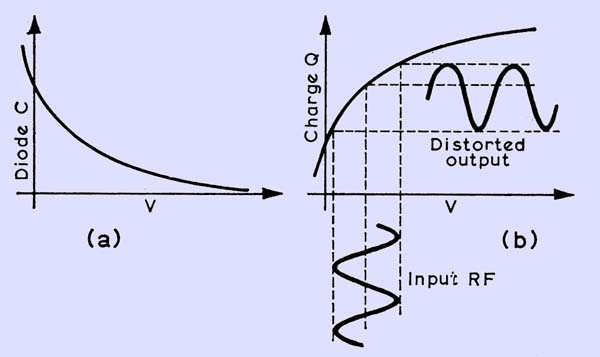
(a) Capacitance and (b) charge variation against
bias on diode. Note the distorted output in (b)
The
curves for a capacitor are all markedly non-linear and this property can be used
as an element in a circuit to modulate, demodulate and multiply frequency. This
is non-linear reactance, rather than a resistance, however, and because of this,
very little loss occurs.
The
charge in a capacitor is equal to the capacitance multiplied by the voltage
across the capacitor: Q = CV, and the capacitance/voltage curves above
approximate very roughly to the reciprocal of the square root of the applied
voltage. Combining Q = CV and C approx l/V*0.5, the charge on the capacitor can
be seen to be proportional to the square root of the voltage. If an RF voltage
is applied to a capacitative reactance which behaves in this manner, a heavily
distorted charge, consisting mainly of the second harmonic of the input, is
produced and can be tapped off using a tuned circuit. A diode used this way is
called a varactor diode. This action can easily be demonstrated by using a zener
diode as the non-linear element and a signal generator tuned to about 500 kHz
giving an output of about 0.25 to 0.5V rms.
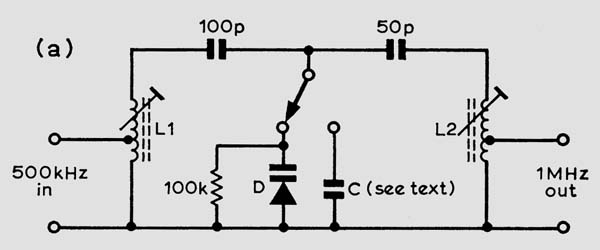
Circuit for demonstrating non-linear reactance
effects.

The circuit broken down into its basic components.
In
diagrams (a) and (b) above the circuit is in two halves: the left-hand part is
tuned to 500 kHz and the right-hand part to 1 MHz. RF current is passed through
the diode at 500 kHz and, due to the non-linear reactance of the diode, a
proportion of its second harmonic will (or should be) circulating in the
right-hand part of the circuit. L1 and L2 are IF transformer coils: L1 could be
two coils in series (aiding), tuned to resonate at 500kHz with the diode in
circuit, and L2 one coil tuned to resonate at 1 MHz. Resonance can be measured
across the complete coil with a low-capacitance, high-impedance RF probe. Having
tuned each circuit, apply 500 kHz to L1 and measure the output across L2. Tune
this coil up very carefully (the resonance peak is very sharp). To prove this
frequency has been produced by the diode and is not just generator harmonics
slipping through, apply 1 MHz from the generator to L1 and see how much of this
gets through to the output. With any reasonable Q in the coils, it will not be
very much. Another proof would be to replace the diode with an equivalent
capacitance; the output will go down to a very low proportion of the previous
value.
Other
harmonics can be produced in a similar way. The second harmonic can mix with the
fundamental and produce the third, and the second can produce its own distorted
charge for the fourth harmonic, although the output of the fourth harmonic is
improved if the third is produced as well. In all these circuits for
multipliers, current must be allowed to circulate through the diode at all the
respective frequencies by circuits that are tuned to those frequencies. These
circuits, excepting the output circuit, are called idlers. All tuned circuits
have to be of the maximum unloaded Q to minimize circuit loss and they can be
considered either as parallel- or series-tuned, depending on which way one looks
at them
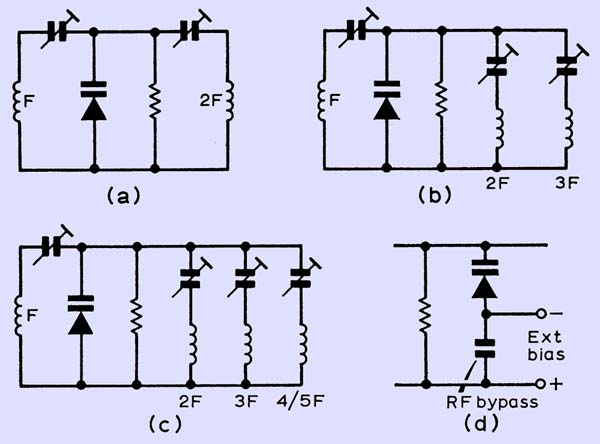
Various varactor multipliers: doubling in (a),
tripling in (b) and quadrupling or quintupling in (c). (d) shows a way of
altering the bias to make the input RF lie along some other point of the curve
and possibly to improve the effect.
the
diode average capacitance (at a certain voltage) is in series with the tuning
capacitance and both of these tune the coil. A properly-designed doubler of this
kind, using a diode specifically meant for this function, can give an output of
about 90 per cent of the input, the rest being dissipated in circuit
resistances. When multipliers of this sort were first used, some surprise was
expressed that they could be fed with an AM input. This cannot normally be done
with a frequency multiplier, at least to get a coherent output, but it seems
that a non-linear reactance can demodulate at the input frequency and remodulate
at the output frequency (with a little added harmonic distortion), to give an
output which is at least intelligible.
Another
use for varactor or charge-storage diodes is in, parametric amplification. If a
certain charge is fed into the diode capacitance at the crest of an RF
half-cycle and then the capacitance is suddenly decreased, the voltage
associated with this charge becomes larger: Q = CV. With C reduced to half its
original value, the voltage would double for the same charge. The potential
energy of this charge, which is equivalent to ˝CV*2, would double as well.
Obviously this would need some form of outside energy to make up the difference.
If the capacitance is suddenly returned to its original value when the RF
voltage becomes zero between its positive and negative half-cycles, no
additional energy is needed because the PD across the capacitor is zero. Some
energy has to be supplied to the circuit twice every cycle: RF energy at double
the frequency. This RF energy, which is called the pump frequency energy, must
also be in phase with the original frequency wave crests. Part of this pump
frequency energy is transferred to the original frequency and amplifies it. The
processs is called parametric amplification. As it stands, it would be quite
difficult to carry out in practice because of the necessary phase relationship,
but this relationship can be obtained simply by letting the pump frequency beat
with the original frequency and providing an idler circuit for the beat
frequency to circulate as is shown below.
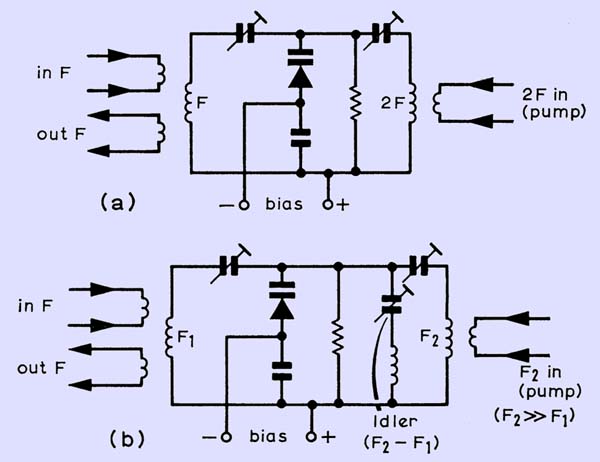
(a) Basic series-tunes parametric amplifier.
(b) Parametric amplifier with idler.
Of
course, the idler circuit can provide a useful output of the difference
frequency as a mixer, but care needs to be taken not to load the circuit too
heavily. This method of amplication or mixing can, if done carefully, provide a
really worthwhile gain and considerably less noise than most other methods but,
as with all amplifiers, the parametric system can be considered to show negative
resistance and can readily oscillate at the input or idler frequencies if given
a chance: eg when the tuned circuit and diode losses are cancelled by this
negative resistance. It thus seems to be a matter of balancing Q values in the
various circuits against each other to get the best results.
This
negative resistance and amplification mentioned above has been obtained through
energy supplied from an outside RF source.
FM modulators using varactors
There are two types of FM
modulators - direct and indirect. Direct FM involves varying the
frequency of the carrier directly by the modulating input. Indirect FM
involves directly altering the phase of the carrier based on the input (this is
actually a form of direct phase modulation.
Direct modulation is usually accomplished by
varying a capacitance in an LC oscillator or by changing the charging current
applied to a capacitor.
The first method can be accomplished by the use
of a reverse biased diode, since the capacitance of such a diode varies with
applied voltage. A varactor diode is specifically designed for this
purpose. Figure 1 shows a direct frequency modulator which uses
a varactor diode.
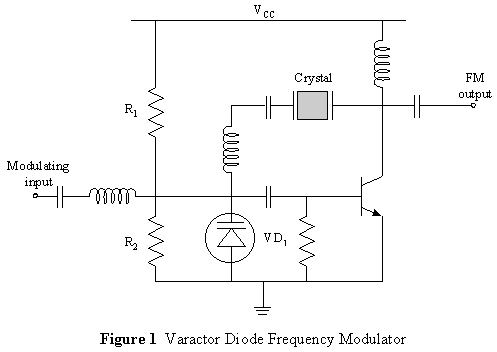
This circuit deviates the frequency of the
crystal oscillator using the diode. R1 and R2 develop a DC voltage across the
diode which reverse biases it. The voltage across the diode determines the
frequency of the oscillations. Positive inputs increase the reverse bias,
decrease the diode capacitance and thus increase the oscillation frequency.
Similarly, negative inputs decrease the oscillation frequency.
The use of a crystal oscillator means that the
output waveform is very stable, but this is only the case if the frequency
deviations are kept very small. Thus, the varactor diode modulator can only be
used in limited applications.
The second method of direct FM involves the use
of a voltage controlled oscillator, which is depicted in figure 2.
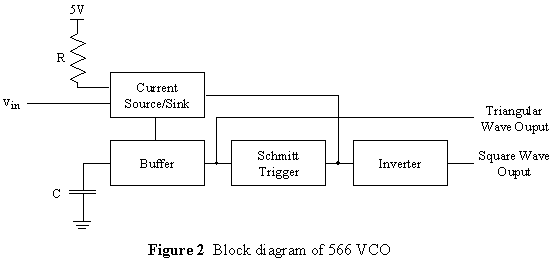
The capacitor repeatedly charges and discharges
under the control of the current source/sink. The amount of current supplied by
this module is determined by vIN and by the resistor R. Since the amount of
current determines the rate of capacitor charging, the resistor effectively
controls the period of the output. The capacitance C also controls the rate of
charging. The capacitor voltage is the input to the Schmitt trigger which
changes the mode of the current source/sink when a certain threshold is reached.
The capacitor voltage then heads in the opposite direction, generating a
triangular wave. The output of the Schmitt trigger provides the square wave
output. These signals can then be low-pass filtered to provide a sinusoidal FM
signal.
The major limitation of the voltage controlled
oscillator is that it can only work for a small range of frequencies. For
instance, the 566 IC VCO only works a frequencies up to 1MHz.
A varactor diode circuit for indirect FM is
shown in figure 3.
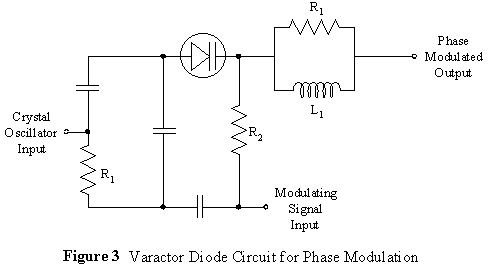
The modulating signal varies the capacitance of
the diode, which then changes the phase shift incurred by the carrier input and
thus changes the phase of the output signal. Because the phase of the carrier is
shifted, the resulting signal has a frequency which is more stable than in the
direct FM case.








